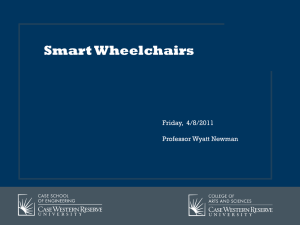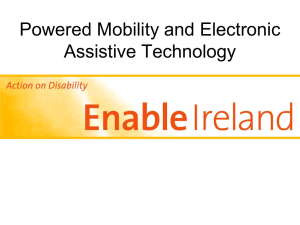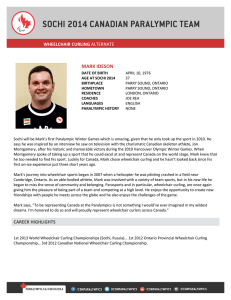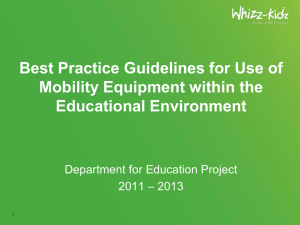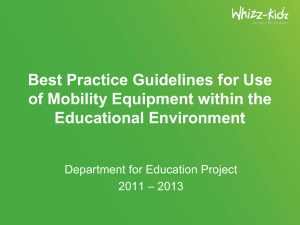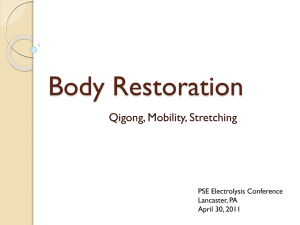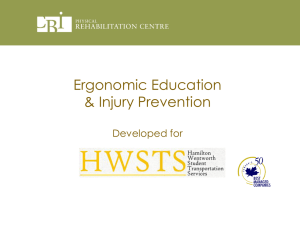Best Practice Guidelines for Use of Mobility Equipment - Whizz-Kidz
advertisement
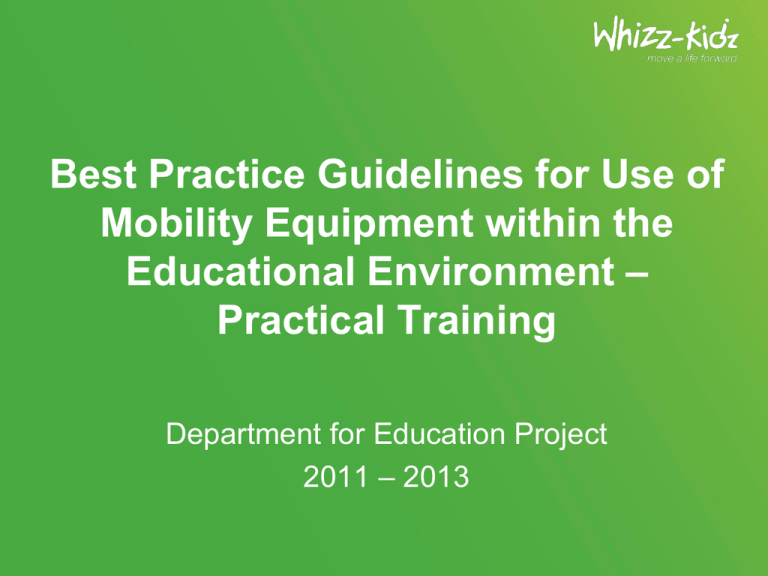
Best Practice Guidelines for Use of Mobility Equipment within the Educational Environment – Practical Training Department for Education Project 2011 – 2013 Outline of Presentation • • • • • • Introduction Advantages of Independent Mobility Importance of Seating and Postural Management Measuring for the Correct Wheelchair Tips for Wheelchair Skills Training Any Further Information? Introduction to Whizz-Kidz • • • • • Medium sized national charity Independence to enjoy an active childhood Life Journey approach Highly qualified mobility therapists Partnership working within the NHS What we do We give disabled children and young people across the UK customised mobility equipment, training, advice and life skills. But more than this, we give them the independence to be themselves. We make an immediate and life changing difference to them, their families and their communities. Introduction Number of disabled children using assistive technology has increased by 60% (Long et al 2003) “…the window that enables a child to have greater independence and more active involvement in play.” (Judge 2002) Advantages of Independent Mobility • A child is expected to learn more about their world through movement • Benefits increase interactions with people, objects and surrounding environments • Aids the development of cognitive, emotional and psychological skills • Interactions create sense of achievement and autonomy leading onto further exploration Lack of independence may mean: • decreased motivation • reduced confidence • feelings of frustration • passive • incurious • learned helplessness Nisbet 2002 Advantages of Independent Mobility Research shows that children should be provided with equipment to enable them to become independent as close as possible to the age when mobility would be occurring naturally within normal childhood development Butler 1986 Posture and Seating What is postural management? “… the control of an individual’s body posture, recognising that postural stability is a fundamental necessity for effective functional performance” Three aims of seating intervention: 1. Seating for postural control and deformity management 2. Seating for pressure management 3. Seating for comfort and postural accommodation Hobson and Molenbroek 1990 Importance of Postural Management It is vital that children and young people who are seated in their wheelchairs for long periods at a time recognise: 1. how important posture is 2. the influence it has on their everyday functioning 3. the problems it can cause 4. their reduced ability to change their own position, as well as the affects of tone and gravity, can lead to serious secondary complications. 5. good seated posture relates to balance and stability 6. it is the method by which we support the body so that maximum performance is achieved with minimal energy. Importance of Good Posture Did you know that poor seated posture can contribute to the following problems? • skeletal contractures • tissue breakdown leading to pressure ulcers • reduced functional performance • respiratory difficulty and infections • urinary tract infections • digestive difficulties • general discomfort and pain Importance of Good Posture Pelvis Common pelvic deformities: • Posterior pelvic tilt • Anterior pelvic tilt • Obliquity • Rotation Checklist • Is the child’s pelvis level? Place your hands on their hips and if one looks higher than the other, then they won’t be sitting level. • Likewise, if one hand appears to be further forward that the other, then they are twisting their body. • Are the child’s knees facing forward or off to an angle? This is also a good indication as to the position of their pelvis. Importance of Good Posture Spine and Trunk Common spine / trunk deformities: • Scoliosis • Lordosis • Kyphosis • Rotation • Protraction • Retraction Checklist • Are the child’s shoulders level and front facing? • Where is their head? Is it difficult for them to look upwards? • Do they lean on one of the armrests more than the other? • All these questions could indicate that this individual requires additional support in sitting, and if not provided, could lead to longer term problems with their spine. Importance of Correct Size Wheelchair Children and young people who have issues with immobility, poor postural control or decreased sensation frequently cannot maintain proper positioning or are unaware that they are not maintaining an upright, symmetrical posture. As discussed previously, asymmetrical posture can lead to many secondary complications with function, skin integrity, breathing, swallowing and digestion. Therefore , it is imperative that the wheelchair size be measured appropriately for them. Wheelchair dimensions - width Seat width is usually close to the hip width or the widest part of the body. Seat width too wide: 1) Pelvic obliquity and scoliosis 2) Effect positioning of secondary supports 3) Impede access to wheels or joystick 4) Impact upon accessibility Seat width too narrow: 1) Create rotational deformities 2) Cause discomfort 3) Increase pressure on the thighs or lower legs. Wheelchair dimensions - depth The seat depth should be slightly shorter than the upper leg length. Seat depth too long: 1) Create slumping in the seat, sliding out of seat, pressure problems 2) Increases overall frame length 3)Impede transfers Seat depth too short: 1) Cause postural problems at pelvis 2) Increase pressure on buttocks 3) Impede transfers Wheelchair Skills Training • Providing disabled children with wheelchairs means making sure they know how to use them to their full potential • Improving confidence and independence in the process • Achieving individual potential through a codified programme of wheelchair skills training • Schemes of work for complex needs, beginners and advanced users Wheelchair Skills Training Whizz-Kidz delivers approximately 72 courses to 750 children and young people 40 schemes will be held within the school environment Involvement of school staff promotes a ‘carry-over’ effect of skills taught Wheelchair Skills Training Wheelchair trainer coordinators are wheelchair users themselves, which raises aspirations of the participants and provides them with valuable role models. Running these courses in schools increases staff confidence and gives them the chance to see the equipment in use. Wheelchair Training Tips Manual Wheelchair – Moving forward on a flat surface 1. Grasp the hand-rims and push evenly with both hands. 2. Position hands at 11 o’clock for starting the stroke. 3. Release hands at 2 o’clock for finishing the stroke. 4. Use smooth strokes matching the speed of the moving wheel. 5. Avoid jerky accelerations that could cause the wheelchair to tip over backwards. 18 Registered Charity No. 802872 Wheelchair Training Tips Manual Wheelchair – Moving forward on a flat surface 6) Lean forward to avoid lifting the front wheels off the ground. 7) Push with longer, less frequent strokes, allowing coasting where possible. 8) Ask the user to touch their middle fingers onto the axles during recovery phase to reinforce a circular propulsion pattern. Wheelchair Training Tips The recovery path of the stroke can be: a) along the handrim b) below the handrim c) above the handrim d) below and above the handrim Below the hand-rims is commonly recommended. Manual Wheelchair – Stopping The rate of slowing can be controlled by how hard the hand-rims are gripped. The hand-rims should run through the wheelchair user’s hands. If the wheelchair user stops too quickly, they may tip over forwards. To prevent this, the wheelchair user should lean back whenever they are required to stop quickly. Wheelchair Training Tips Manual Wheelchair – Turning whilst moving forward 1) When turning around an object (e.g. a corner wall), the turn should not begin until the axles rear wheels have reached the object. 2) Slow down the inside wheel. 3) Push harder on the outside wheel. 4) Break a turn down into its parts: driving straight, turning, then driving straight again. Wheelchair Training Tips Power Wheelchair – Moving forward on a flat surface 1) Don’t overcrowd the user. One person only taking charge and giving instructions. 2) Driving the wheelchair in circles is an acceptable first time movement. 3) It is acceptable for the child to bump into things initially. If a child persists in doing so intentionally, the instructor should consider greater rewards for following instructions. 4) Power wheelchairs may be rear-, front- or mid-wheel- drive. This affects the drive path and ease of moving wheelchair forward. 5) If the user is over-correcting when driving, changing the contact point with the joystick may improve the fluidity of the driving. 6) If the user’s hand control is limited then alternative access can be considered. Wheelchair Training Tips Power Wheelchair – Stopping • The first instruction that a first time power chair user should understand is ‘stop’. • Explain to the child or young person that when the command to stop is given, it must be acted upon. • Demonstrate the command, and use a hand gesture to accentuate this. • Make sure the user is clear on this instruction before they move the wheelchair for the first time, and provide clear praise when this is followed. References Butler C (1986) Effects of Powered Mobility on Self-Initiated Behaviours of Very Young Children with Locomotor Disability Developmental Medicine & Child Neurology Vol 28: 325-332 Hobson DA, Molenbroek JFM (1990) Anthropometry and Design for the Disabled: Experiences with Seating Design for the Cerebral Palsy Population Applied Ergonomics Vol 21(1): 43-54 Judge S (2002) Family-Centered Assistive Technology Assessment and Intervention Practices for Early Intervention Infants and Young Children Vol 15(1): 60-68 Long T, Huang L, Woodbridge M, Woolverton M, Minkel J (2003) Integrating Assistive Technology Into an Outcome-Driven Model of Service Delivery Infants and Young Children Vol 16(4): 272-283 Nisbet PD (2002) Assessment and Training of Children for Powered Mobility in the UK Technology and Disability Vol 14: 173-182
